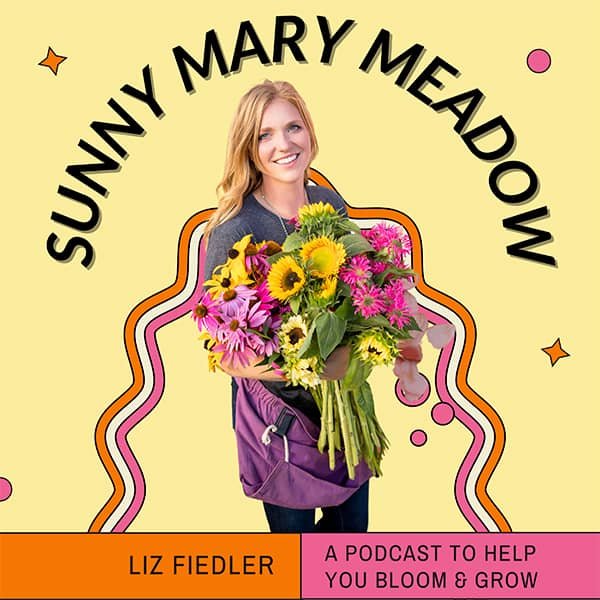
Welcome back to another Sunny Mary Meadow podcast/blog post. I am your host, Liz Fiedler, and today we are going to be digging deeper into dahlias. You guys absolutely loved the couple of episodes that we already put out about the dahlias and people have been saying, “Hey, give us more dahlia content.” So, here we are. Unfortunately, due to scheduling conflicts, I wasn’t able to get The Twins (Megan and Mallory from Blooming Creek Flower Farm) to join me this time. This post and the next dahlia one are going to be a little bit more informational, and just a little bit different, than the earlier two dahlias episodes were. If you haven’t read or listened to those yet, The Twins joined us for Dahlias – Part 1 and Dahlias – Part 2. We now have Dahlias – Part 3, and I bet there’s going to be a Dahlias – Part 4.
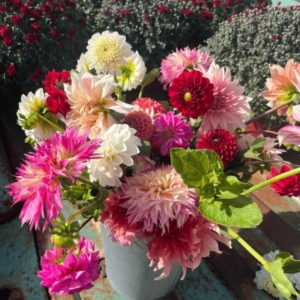
You know, when it comes to flowers, it’s kind of like food – there’s steak, and there’s desserts, and there’s entrees, and there’s appetizers. With flowers, there’s so much variety, and when it comes to cut flowers, dahlias could be a dessert. And within that “dessert” category there are so many kinds, and they have their own classifications, like cakes, cookies, macrons, etc. are all types of desserts. So, we’re gonna kind of get into that.
As we’ve talked about in earlier episodes/posts, I’m in Zone 4b in Minnesota, so that gives you some reference of where we’re located. Most of the time, most growers around here will wait until the spring to do their dahlias sales, because that’s when they need to be planted. I am not sure if I will end up doing a dahlia tuber sale. If I do, I would maybe just sell some to local people. I don’t know if I will ever get to the point where I ship them out. It just kind of depends on what my business model is at the time, and the resources and the help that I have to do it. It’s a lot of work and takes a lot of manpower to divide the dahlias.
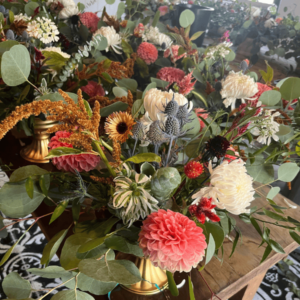
The Twins have a really good dahlia sale in the spring, and they like to wait until the spring because they don’t know how their customer is going to store them. If they sell their dahlia tubers in the fall and they tell you, “Okay, you need to store it this way, this way, this way, etc. to make sure it stays alive. You don’t want it to get dehydrated, you don’t want it to get mushy, you don’t want it to get moldy, etc.” If you’ve never done it before, the odds are that in the spring they’ll get a bunch of nightmare emails that say, “My dahlia tuber died.” These tubers are living things, they’re just dormant, so for that reason, they like to wait until the spring to see what they have and make sure that they stored it properly. Losses can happen even when you know what you’re doing, so they want to make sure that their tubers have survived the winter. Then once they know what they have, they say how many they have for sale, because they also need to keep some for their own flower farm/for their own business. They’ll see how many extras they have of the different varieties, because they don’t need 100 of each plant.

However, there are a lot of flower farms that will do their sale in the fall. They say, “You know what, you’ll get these individual tubers and it is up to you to keep them alive.” With some of the rare types of tubers, I can’t even describe how ruthless it is on some of these websites when their sales go live. You have to have your list ahead of time, add to cart, and checkout immediately. I mean, it is worse than trying to get Taylor Swift tickets. I’m not kidding. It’s really hard to get these rare varieties. And what I’m finding for my business, is that my customers may like a color, they like a style, but besides that, they don’t really care how rare they are. If I say “Well, this dahlia is really expensive, so this bouquet is $45 because it has this kind of dahlia in it,” that’s not what my customer wants. They like it if it’s a pink dahlia or a blush color dahlia, but they’re not going to necessarily want to pay a premium for it being a rare variety. That’s not the type of product that I sell. Whereas I think, with The Twins’ flower farm, Blooming Creek, people go there to see different kinds of dahlias because they have 50 different varieties. Dahlias are their specialty, whereas I’ve got 500 dahlia plants, but not as many varieties. As long as I have some dahlias in each bouquet as focal flowers, my customers are pretty happy.
There is a lot to keep in mind when you are choosing your dahlias and you’re trying to buy some tubers – the American Dahlia Society (the ADS system) classifies dahlias into six different sizes, 20 forms, and 17 colors. I’ve gathered a lot of this information from both the American Dahlia Society website and Erin Benzakein from Floret Farms. Erin has a book called Discovering Dahlias and it is an amazing book. It’s beautiful and is such a good guide.

Before I get into the specifics about sizes, forms, and colors, I want to provide a quick reminder about the anatomy of a tuber … remember, tubers are like roots or like a potato. They need a body, a neck, and an eye. If they don’t have an eye, they’re not going to produce that plant for next year. So it’s just like with potatoes, you can cut them in half, cut them in fourths, but only if they have a little eye (a sprout). Sprouting is where it’s going to produce a new plant. The tuber can be skinny, it can be fat, it can be long, it can be short … it doesn’t really matter. The tuber size does not equal plant size and the tuber size does not equal flower size. The same exact plant can give off different-sized tubers. Usually, they’re fairly uniform – they’re all kind of either short and chunky, or long and skinny, or whatever they might be. Some of them, especially the pencil-thin ones (if that’s what you get) can be hard to store. So, those are ones that I especially like to wait until the spring to divide, because I feel like they have a better chance of surviving the winter if they’re all kind of clumped together with dirt around them.

The American Dahlia Society says there are six sizes of dahlias and other groups say eight sizes. The sizes we are going to talk about are pompon, mini ball, miniature, ball, small, medium, large, and giant.
- Pompon – are up to 2 inches in size and they’re about the size of a lollipop. They’re really cute in little bouquets. They kind of look like Craspedia flowers. Think of it as like a bubblegum sucker or Tootsie Pop size. That’s kind of what they look like.
- Mini ball – are 2 to 3.5 inches in size.
- Miniature – are up to four inches in size.
- Ball – has to be a rounded shape and over 3.5 inches. This is what most cut flower growers will grow around here because they’re just so versatile. They’re big enough for event work like weddings and bigger centerpieces, but they’re small enough for smaller market-size cut flower bouquets. And they have a really long vase life – the bigger and more delicate the dahlias get, they only last a few days in the vase.
- Small – are 4 to 6 inches in size.
- Medium – are 6 to 8 inches in size. This is about the biggest that people will go for actual flower arranging.
- Large – are 8 to 10 inches in size.
- Giant – are 10 inches or larger.
Once you get into the large and giant sizes, they are very delicate. They are the ones entered in the State Fair for a contest. They are the ones entered by the American Dahlia Society just to grow for the sake of growing and for size. And bigger isn’t always better. It’s kind of like the largest pumpkin probably doesn’t taste very good. The largest steer probably doesn’t taste very good. These giant dahlias are delicate and they’re used for contests, but they’re not exactly useful in any sort of design work unless it is a same-day event with a huge installation for a wedding or something like that, but they’re not exactly practical. That’s why these flowers can be so expensive.
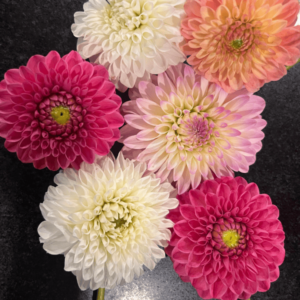
The large ones that are around 8 to 10 inches or the medium ones that are 6 to 8 inches are really, really cool in your garden, but you’re not necessarily going to use them for cutting. They can last significantly longer on the plant than they would in the vase, so that’s what can be really cool about them. We’ve talked in a previous post about dahlias, and how it’s so important to pinch them so that you get smaller stem sizes (the actual stem, not the flower) when you’re growing them to be cut and put in a vase, so the stem is not the size of a broomstick. When you pinch them, they branch off and they produce more flowers. But with these giant dahlias, if you don’t pinch them, they can get like eight feet tall, which is kind of a cool statement piece in a garden. There are people that put giant dahlias in their backyard and don’t pinch them, and if that’s the look you’re going for that’s okay, but know that you’re only going to get one stem and it’s only gonna be blooming for a couple of weeks, kind of like a sunflower.
So after you have the different varieties, which basically correlate to the size, then we have the forms. It’s important to know when you’re buying these dahlias that sometimes they don’t have a photo on them. The first time I bought some tubers and I had no idea what I was looking for, I was like, “Well, I want some dahlias. This name of variety looks cool,” and they didn’t have a photo next to it. It was just a local grower, and I totally understand that they didn’t have a picture because I don’t have time to take pictures of all of the dahlias that I grow. I wish I did. I might have some pictures of it in a bouquet, but I don’t have this perfectly organized collection of photos to use. I don’t have a professional photographer here, so sometimes it’s just the name of the dahlia. There are 18-20 forms (depending on what you’re reading) and it’s important to know which ones you like and what the use is going to be for them.
So, there’s Informal Decorative, Formal Decorative, Stellar, Peony, Orchid, Orechette, Single, Mignon Single, Collarette, Semi Cactus, Straight Cactus, Incurved Cactus, Lacinated, Waterlily, Anemone, Ball, Miniature Ball, Pompon (what’s confusing is those last three are size classifications and they are forms/shapes).
The cactus ones are kind of spiky-looking. They look like a sea creature of some sort. There are some cactus ones that I love – Kogane Fubuki is one that I have that everyone seems to love, but it doesn’t have a very long vase life. It looks really unique, but I let people know that “It’s not here for a long time, it’s here for a good time.” The cactus forms, the dinner plate ones, and large decorative ones (the 4-to-8-inch diameter varieties) don’t last very long in the vase, but they look beautiful. So, when you’re using them for market-fresh bouquets, they’re not exactly the best.
I really, really liked the Anemone variety. They almost look like a coneflower … at least that is how I would describe them. They’re really pretty unique. I definitely want to get some of those… And then there’s some novelty ones that are just a little bit more unique looking and have that open center.
Some dahlias can look a lot more like daisies or orchids. Orchid dahlias are actually a form where they have an open center and they look more like a unique zinnia or a unique cosmos, and they just look so different.
These are examples of different types of dahlias that people don’t necessarily see value in as cut flowers. If I put a whole bunch of those in a bouquet and I say, “Yeah, those are dahlias. Those are $4 a piece” (or whatever they might cost). Customers want the dahlias that they’re used to. They want the waterlily style with more of the curved petals or the ball form, so it’s important to know which form you’re looking for when you get on these sales.
For bouquets, I like the ball, or the miniature, or the pompon varieties best. They’re that circular shape and they work really well in a lot of different event pieces and bouquets for cut flowers.

So if you’re looking for dahlias to invest in as a cut-flower farmer, I’d say, “Don’t just buy the fun ones. Don’t just buy the ones you like. Buy ones that are going to be useful in bouquets, if you’re trying to sell them … and those are the ball varieties.” I would also say color-wise you can never go wrong with whites, at least right now. That’s the color trend because you can mix them with other things. I’d say go with whites and corals.
The other thing that I like to keep in mind is for me in Minnesota, they are not prolific enough until late August and that’s when people are in the mood for fall. So I don’t like to do a lot of hot pinks, I’ll do more blush, pinks, and corals, even though I love the hot pink ones. Those are my favorites, but people don’t want those in September. Those are hard to mix in with bouquet arrangements in the fall, so I try to steer away from those colors of dahlias because they’re not fall colors anyway. I tried to go with more moody colors – dark purples, the Ivanetti, the Cornell Bronze, etc.
Speaking of colors, the American Dahlia Society has classified 17 different colors of dahlias. We’re gonna go through what some of those color classifications are. So what I’m going to do is I’m going to talk about some of the color categories and tell you my favorite in each. I mean there’s 100 varieties for every single color, so I’m gonna say my favorite one or two within those.
White – A couple of examples of white dahlias are the AC Casper and Boom Boom White. AC Caspers are decorative big ones that kind of resemble Café au Laits … not super close, but they’re the dinner plate size ones. Boom Boom White is the one that I enjoy doing the most. I have a ton of those and I’m going to plant way more of them next year. Sometimes they blow their center open, but for the most part, they don’t. They’re 3 to 4 inches, creamy white, ball-shaped, with strong stems. They’re great for weddings, events, or just regular bouquets. So that’s my favorite variety of white.
Yellow – I would say if I was going to get some yellow ones, I really enjoy CG Amber. They have kind of a glossy, green foliage. They’re the ball variety that I like.
Blush – When it comes to a blush and champagne, my favorite is of course it’s the Café au Lait, which is the queen, right? That is literally the queen of all flowers – the Café au Lait dahlia. I have about 100 of them. They are just so well known and I try to make sure everyone gets at least one of those in a subscription at some point. But again, I tell people it’s gonna die after three or four days, it just is. We’ll probably talk about vase life in the next episode (Part 4). The other blush variety that is really popular is the Wizard of Oz, which is a mini ball. So those are the two I would do if I was getting the blush varieties.
Peach – These are great because they can be more of an orange or a pink. You can mix them with a lot of things. They can mix with summer colors, they can mix with fall colors, and they can transition for a long time. So, that would be the one color I would really go heavy on if you were trying to just get started with which ones you’re going to do. I love my Jowey Nickys. They’re just a really good ball color. I also really like peaches and cream. The Twins grow a ton of these and they’re just exquisite. They are truly exquisite. They’re these salmon petals that kind of fade down to white at the tips, and they’re just perfect.
Orange – They can be more of a bronze color. Cornell Bronze is the variety that I have a ton of and I really liked those. And I like the Brown Sugar color, as well, but they can get a little bit more pink, I think. That’s the other thing to keep in mind – two plants right next to each other, of the same exact variety, can be totally different.
Coral – My favorite coral ones are Snoho Doris and Snoho Jojo. I bought a couple of those tubers from The Twins and they’re very prolific, they’re beautiful colors, and I love them. This is another color palette I would really go heavy on if I were starting. For example, if you’re going to buy 10 tubers to start with, I would grab a couple from the coral color family because again, think about when they’re blooming. You don’t want a ton of spring colors because they’re blooming in the fall.
Raspberry – I don’t do a ton of these colors because of when they bloom. Caitlin’s Joy is probably my favorite, along with Daisy Duke. I do have a couple of Daisy Dukes, and they produce a lot, but it’s just hard to make them work in my color palette at that time of year. Jowey Winnie would be the other one that kind of transitions to a coral-y color. But again, keep in mind you know that this isn’t necessarily the color that people are going to want in the fall.
Pink – Pink is my favorite color. In fact, it’s my farm’s signature color. Chilson’s Pride is my go-to. I have about 20 of these plants and I don’t think I’m going to sell any of the tubers. I want a whole row of them next year because they have such a long vase life and they do such a great job. They’re slightly fringed, so they’re more textured and add more dimension. They add a little something extra compared to my ball varieties. It’s considered an informal decorative variety rather than a ball, but they do really well.
Purple – There’s one called Genova that’s a mini ball that is really, really pretty. And I also like Nellie’s Rose. Again, I really don’t have any purple ones, because of the reasons that I’ve described. Puff-N-Stuff is the one that I said earlier looks like a coneflower. So if you’re looking for one that looks like a coneflower, I would say go with Puff-N-Stuff. Love that name. And again, keep in mind a lot of lavenders are just really hard to mix within the fall color scheme, too.
Red – I have no idea what the variety is actually called, but I call it “Abe.” One of my customers actually brought over a couple of plants and she’s like, “Here’s the deal. This is my husband’s family dahlias. His grandma gave them to me. Apparently, they started out in Abraham Lincoln’s yard, and they’re passed down, and every grandkid gets one, and everyone’s got to do it. And so now it’s my duty to have these dahlias and I’m gonna give some to you because I don’t know if I can keep them alive. But I want you to keep them alive.” So I have this whole row of them and they bloom really early on. They have this yellow center so they do work pretty well for summer arrangements. They bloom around the end of July, but then they’re not very productive. They don’t keep blooming after that initial flush, at least they haven’t in the last couple of years. So I’m probably going to reduce mine down and only keep a few tubers of those. Reds are hard to do. Maroon and Black – This is another category I would also go pretty heavy on. Jowey Marilyn is a really pretty variety. And Ivanetti. If you’re going to buy some blooms, Ivanetti is where I would go. It just mixes in with those fall and moody colors. And you can turn really any color palette a little bit more fall if you add a few of these in there. Even some pinks and blushes, all of a sudden, if you add some of these, it becomes fall. I don’t know why, I don’t know how it works, but it just does.
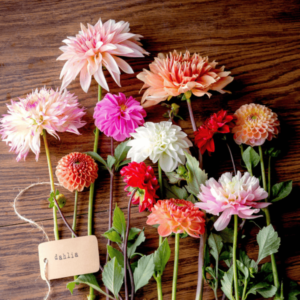
So, those are the examples of my favorite varieties within those colors. When you are buying your tubers, I would really suggest finding a local grower, maybe one that you can pick up in person. Or you can do shipping, but keep in mind that shipping can be tricky because of weather and all that. If you’re in the Minnesota/Wisconsin area, I’d recommend going to The Twins’ site – Blooming Creek. And I’ve bought tubers from The Grove Flower Farm – she’s based out of Wisconsin. It’s not hard to find them somewhat locally. I would not go with a big box store. They hack up their dahlias. It’s just different care that’s put into them. There’s a reason they command the price they do but think of it as an annual if that helps. You’re gonna pay $20 for one hanging basket. A dahlia tuber is an entire plant that is extremely prolific, and there’s a lot of work that goes into dividing the dahlias.
So that’s my guide to classifying dahlias.
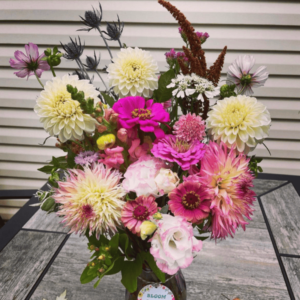
One last thing … podcast listeners & blog readers, I have an ask of you. Between planning these episodes, recording, editing, uploading, and transcribing the podcast to a blog, and the fees to even have an account, this podcast/blog takes a lot of time, effort, and resources. I’m fortunate to have a team helping me out but it’s time to evaluate where this podcast is going and if we can continue doing this. I have had so many messages and emails letting me know that this podcast/blog has brought some bit of joy to people’s day or week and is entertaining, inspiring, or on some other day just improves their life, their drive, whatever it might be. I want to keep this podcast/blog focused on content that informs, entertains, and is mindful of your time. One way to accomplish this is through direct listener support. Your support would help the podcast & blog not only continue but grow. Because of these, we are introducing Sunny Mary Meadow Premium. It’s a way you can quickly and easily support the podcast/blog, and the whole thing takes about 60 seconds. We are asking for $7 per month to help continue our mission of educating and entertaining you. If the Sunny Mary Meadow Podcast and/or Blog is a part of your day or week, and you love what you’re hearing/reading, please consider supporting us. As a special thank you, you will receive access to weekly bonus podcast episodes of what we did on the farm that week. They will be anywhere from 5 to 15-minute episodes. So think of that $7 as a high-five to keep us going and creating the episodes. It’s less than $2 a week just to keep us going and allow us to share this information with you. Thank you for your support!
Additional Note from Liz: Hey, everyone! I want to talk quickly about my course that I’m launching this fall, Peddling Perishable Products. Essentially, if you like the episodes where I tell you how to grow the flowers, I really think you’re gonna like the episodes where I tell you how to sell the flowers. Ultimately, I tried creating some podcast episodes talking about how I do things, and it just felt incomplete, and I really want to make a difference. I want to make it easier on you, and I don’t want you to find out how to do things the hard way.
If you want more information on how to sell your flowers and turn them into a comprehensive business, go HERE and sign up for a Calendly call. I promise it’s not intimidating. It’s 15 minutes where I’m going to tell you the stats on my sales, and I’m going to ultimately give you information on the course. If, at the end of the phone call, the answer is no or not yet, I promise no hard feelings. I just really, really want to help you turn your flower hobby into a successful business if that’s what you want to do. Again, no hard feelings, just sign up on the Calendly link. Thanks!
Thanks for reading the Sunny Mary Meadow blog. If you like what you’re reading, please subscribe to the podcast and rate us. You can also find us on Instagram, Pinterest, and Facebook.
You can subscribe to our email newsletter below. We love to hear any podcast-related feedback at our email podcast@sunnymarymeadow.com, and all other inquiries can be sent to liz@sunnymarymeadow.com.

